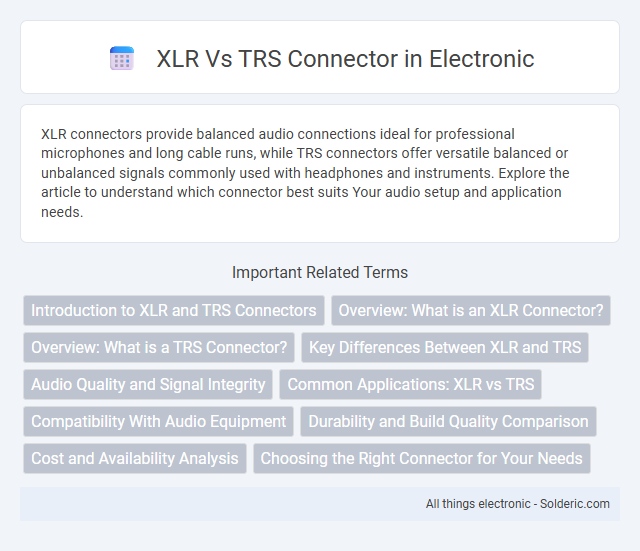XLR connectors provide balanced audio connections ideal for professional microphones and long cable runs, while TRS connectors offer versatile balanced or unbalanced signals commonly used with headphones and instruments. Explore the article to understand which connector best suits Your audio setup and application needs.
Comparison Table
| Feature | XLR Connector | TRS Connector |
|---|---|---|
| Type | 3-pin balanced audio connector | Tip-Ring-Sleeve balanced audio connector |
| Common Use | Professional microphones and audio equipment | Instruments, headphones, and line-level equipment |
| Signal | Balanced (low noise interference) | Balanced or unbalanced |
| Durability | Robust metal housing | Less durable, often plastic or metal |
| Locking Mechanism | Yes, secure locking latch | No locking mechanism |
| Pin Count | 3 pins (ground, positive, negative) | 3 contacts (tip, ring, sleeve) |
| Use in Audio Chains | Preferred for stage, studio, and broadcast | Common in consumer and semi-professional gear |
| Cable Compatibility | Thicker professional cable (XLR cable) | Standard instrument or headphone cable |
Introduction to XLR and TRS Connectors
XLR and TRS connectors are essential in professional audio setups, with XLR primarily used for balanced microphone connections and TRS commonly found in balanced headphone and instrument cables. Both connectors support balanced signal transmission, which minimizes noise and interference, ensuring high-quality audio performance. Understanding your equipment's input and output options helps you choose the appropriate connector for stable and clear audio connections.
Overview: What is an XLR Connector?
An XLR connector is a professional audio interface commonly used for balanced audio signals, featuring three pins for ground, positive, and negative connections. It provides secure and noise-resistant connections ideal for microphones, mixers, and audio equipment. Your audio setup benefits from XLR connectors' durability and consistent signal quality, especially in live sound and studio environments.
Overview: What is a TRS Connector?
A TRS connector, short for Tip-Ring-Sleeve, is a balanced audio connector commonly used for professional audio equipment, offering noise reduction by separating the audio signal into two channels plus ground. It supports stereo signals or balanced mono signals, making it versatile for headphones, microphones, and musical instruments. The TRS connector typically comes in 1/4-inch or 1/8-inch sizes, providing reliable connections for both consumer and studio environments.
Key Differences Between XLR and TRS
XLR connectors feature three pins designed for balanced audio signals, ensuring superior noise rejection and secure locking during professional sound applications. TRS connectors resemble standard headphone jacks with tip-ring-sleeve sections, supporting balanced or stereo unbalanced signals but lacking the locking mechanism found in XLRs. Your choice between XLR and TRS depends on the need for reliable connections and the type of audio equipment you are using.
Audio Quality and Signal Integrity
XLR connectors provide superior audio quality and signal integrity due to their balanced design, which effectively reduces noise and electromagnetic interference over long cable runs. TRS connectors also support balanced audio signals but generally perform best in shorter cable distances where interference is less prevalent. For professional audio applications requiring high fidelity and minimal signal degradation, XLR connectors are preferred for maintaining optimal sound clarity and consistent signal transmission.
Common Applications: XLR vs TRS
XLR connectors are commonly used in professional audio environments such as microphones, mixers, and PA systems due to their balanced connection that reduces noise interference. TRS connectors are often found in headphones, audio interfaces, and keyboard outputs, providing both balanced and unbalanced signal transmission for versatile applications. Your choice between XLR and TRS depends on the specific equipment and noise reduction needs within your audio setup.
Compatibility With Audio Equipment
XLR connectors provide balanced audio connections commonly used in professional microphones, mixers, and audio interfaces, ensuring reduced noise and interference in signal transmission. TRS connectors, often found in headphones, instruments, and line-level equipment, support both balanced and unbalanced connections, offering versatile compatibility with various audio devices. Choosing between XLR and TRS depends on the equipment's input/output design and the need for noise rejection in the audio chain.
Durability and Build Quality Comparison
XLR connectors feature robust metal housings and secure locking mechanisms, providing superior durability ideal for professional audio applications. TRS connectors typically have smaller, less rugged designs made of metal and plastic, making them more prone to wear and damage under heavy use. The XLR's balanced wiring and stronger construction enhance long-term reliability compared to the more lightweight and exposed TRS connectors.
Cost and Availability Analysis
XLR connectors, commonly used in professional audio equipment, tend to be more expensive due to their robust build quality and locking mechanism, which enhances reliability in studio and live settings. TRS connectors are generally more affordable and widely available, making them a cost-effective option for consumer audio devices and home studios. Your choice between XLR and TRS will largely depend on budget constraints and the intended application, with XLR favored for professional use and TRS suitable for everyday audio connections.
Choosing the Right Connector for Your Needs
XLR connectors provide balanced audio connections ideal for professional microphones and long cable runs, minimizing noise and interference. TRS connectors offer versatility with balanced or unbalanced signals, commonly used for headphones, instruments, and patch cables in various audio setups. Choosing the right connector depends on your equipment requirements, signal type, and the environment in which you'll be recording or performing.
XLR vs TRS connector Infographic

 solderic.com
solderic.com